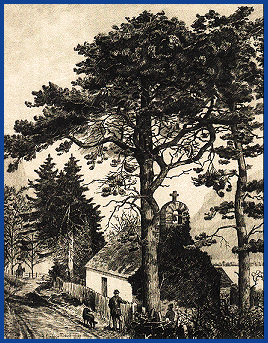
The Elan Valley dams
Memories of the lost valleys
The location of
the Elan Valley dams
and reservoirs
is shown on the
sketch map.
Hetty Price, a farmer’s daughter who lived in the lower Claerwen valley in the 1880’s, recorded some of her memories of the lost valleys when she was in her seventies. Her father’s farm was on the other side of the River Claerwen opposite "the Grand Mansion of Nantgwyllt where the Squire lived."
"At Christmas we always had a treat and Christmas tree in the drawing room at Nantgwyllt, and the young ladies waited on us. It was looked forward to for months."
She recalled the old school attended by the children of the two valleys:
"There was a nice School and School-house attached, kept altogether by Miss Gertrude Lewis Lloyd, a sister of the Squire. She was always doing good deeds, giving suits of clothes for the poorer children, and material to make frocks for the girls."
Nantgwyllt Church,
at the heart of
the valley now
submerged beneath
Caban Coch reservoir,
drawn by
Eustace Tickell
Powys
County Archives
 The
tiny church which served the community was also remembered:
The
tiny church which served the community was also remembered:
"Lower down the road from the School was Nantgwyllt Church
where most of the children and parents of the two valleys went
to worship every Sunday afternoon. The Parson had to come all
the way from Rhayader on horse back. He had a very long beard,
and we children stood in awe of him, and also the Gentry of Nantgwyllt."
The church was drawn by Eustace Tickell in 1893, (left) as one of a series of charming illustrations reproduced in his book "The Vale of Nantgwilt - A Submerged Valley".
The Radnorshire
Society published these
recollections in 1948.
"Just by the Church was the Mill, a lovely quaint old wheel fed by a brook, to saw all the timber for the Estate, and also to grind the oats and barley. Nearly every farmer took their grain to be done in the autumn. There was also a kiln to dry the grain. It was done by night, and most of the young men around would congregate to have a good time around the large fire that was kept up all night."